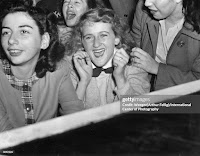The Man Who Created Beatlemania
- jim Young
“Everything that’s old is new again.” - anon
Scottish music promoter Andi Lothian claimed he coined the phrase “Beatlemania” when being interviewed at the Beatles’ Caird Hall Concert on October 7, 1963.
On October 13th, the Beatles starred on “Sunday Night at the London Palladium”, the UK’s top variety show which was televised and viewed by 15 million people. The next day, a national paper claimed they coined the term “Beatlemania” in their headline.
And on the 21st of October that same year, Vincent Mulchrone used the word “Beatlemania” for the headlines of a story in the “Daily Mail.”
Regardless of who coined the actual term “Beatlemania”, the Beatlemania Phenomenon was actually invented prior to that, by publicist George Evans.
Except it wasn’t called “Beatlemania” at the time for the simple reason that the Beatles had not yet met and in fact were only about 2 or 3 years old at the time.
Read on to discover how the Beatlemania Phenomenon was invented, but first, here’s some interesting information about it.
In more recent times the hysteria that was once known as Beatlemania has become widespread at music concerts. Fearing that the study of mass fainting had been “neglected in medical literature”, two German physicians, Thomas Lempert and Martin Bauer attended a New Kids On The Block concert and worked behind the scenes with the first-aid staff where concert-goers who suffered the symptoms of the “Beatlemania Phenomenon” were treated.
 |
| Going... Young Girl at a Frank Sinatra concert. |
Those that did lose consciousness reported a combination of factors which are often associated with a loss of consciousness.
- Sleeplessness the night before due to the excitement of the upcoming event.
- Fasting early in the morning as they lined up for the concert.
- Long periods of standing in the arena.
- Hyperventilation that was worsened when combined with screaming and compression by the pushing masses.
Most of the young girls that fainted and lost consciousness were standing next to the stage where squeezing is at a maximum.
 |
| Going... |
But that wasn’t how it all started. In the 1940s, teenage girls who were known as “bobby-soxers” were drawn to the newest idol of its era, a young unknown singer named Frank Sinatra.
Sinatra had hired George Evans as a press agent when he was booked to sing in the Paramount Theatre in 1942. Evans wasn’t about to take anything for granted. With the help of a dozen bobby-soxers that Evans paid $5 each, Evans secured Frank Sinatra’s rise to star status overnight.
In the basement of the Paramount Theatre these teenage girls were taught to scream and faint in the front row seats. An ambulance was hired to park outside the theatre to add to the drama.
And then something very unexpected happened. While these 12 bobby-soxers earned their $5 payment, about another 20 unpaid teenagers actually did pass-out.
 |
| GONE! |
In the next few weeks, while Evans continued to teach his plants to jump up, scream, faint and throw their bras and panties on stage (a practice that later became more associated with Tom Jones), more and more girls were also being affected by this “Beatlemania Phenomenon” which was of course more fittingly called, “Swoonatra” and “Sinatramania” at the time.
So while the name changed as did the music, the phenomenon was transferred from Sinatra to Elvis to the Beatles and on through the decades.
There may be very real psychological and physiological explanations for this today, but it all started with 12 girls who were paid to scream and swoon for just $5 a piece, thanks to the ingenuity of George Evans in an attempt to promote his client, Frank Sinatra.
Yes, my friends… Those were the days.
- 30 -
Do you have some pictures or memories of the proverbial “good old days” that you would like to share? If so, please send them by clicking on this link, Those Were The Days, My Friend.


Comments
Post a Comment